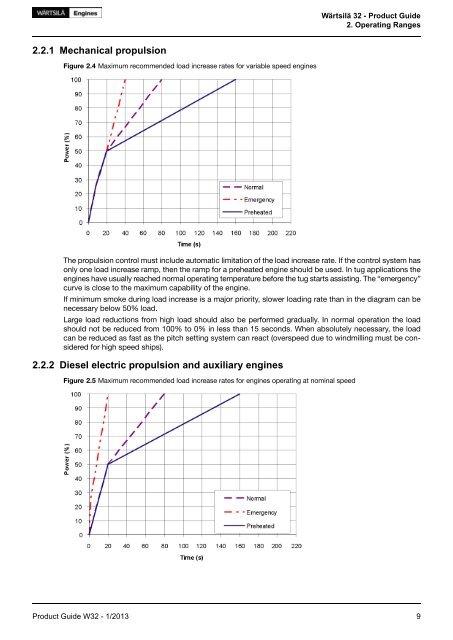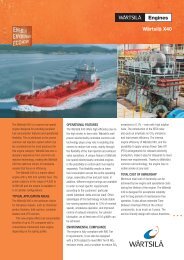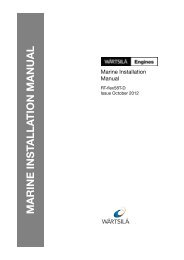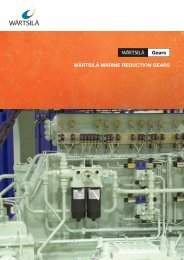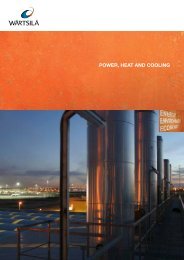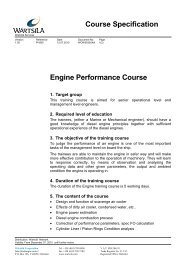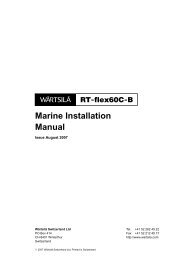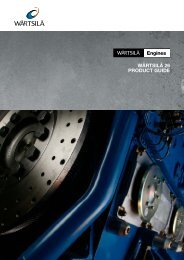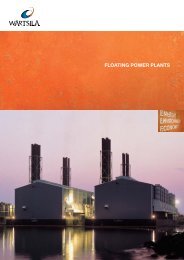- Page 1: WÄRTSILÄ 32 - PRODUCT GUIDE WÄRT
- Page 4 and 5: Wärtsilä 32 - Product Guide Table
- Page 6 and 7: Wärtsilä 32 - Product Guide Table
- Page 8 and 9: Wärtsilä 32 - Product Guide 1. Ma
- Page 10 and 11: Wärtsilä 32 - Product Guide 1. Ma
- Page 12 and 13: Wärtsilä 32 - Product Guide 2. Op
- Page 16 and 17: Wärtsilä 32 - Product Guide 2. Op
- Page 18 and 19: Wärtsilä 32 - Product Guide 3. Te
- Page 20 and 21: Wärtsilä 32 - Product Guide 3. Te
- Page 22 and 23: Wärtsilä 32 - Product Guide 3. Te
- Page 24 and 25: Wärtsilä 32 - Product Guide 3. Te
- Page 26 and 27: Wärtsilä 32 - Product Guide 3. Te
- Page 28 and 29: Wärtsilä 32 - Product Guide 3. Te
- Page 30 and 31: Wärtsilä 32 - Product Guide 3. Te
- Page 32 and 33: Wärtsilä 32 - Product Guide 4. De
- Page 34 and 35: Wärtsilä 32 - Product Guide 4. De
- Page 36 and 37: Wärtsilä 32 - Product Guide 4. De
- Page 38 and 39: Wärtsilä 32 - Product Guide 4. De
- Page 40 and 41: Wärtsilä 32 - Product Guide 5. Pi
- Page 42 and 43: Wärtsilä 32 - Product Guide 5. Pi
- Page 44 and 45: Wärtsilä 32 - Product Guide 5. Pi
- Page 46 and 47: Wärtsilä 32 - Product Guide 6. Fu
- Page 48 and 49: Wärtsilä 32 - Product Guide 6. Fu
- Page 50 and 51: Wärtsilä 32 - Product Guide 6. Fu
- Page 52 and 53: Wärtsilä 32 - Product Guide 6. Fu
- Page 54 and 55: Wärtsilä 32 - Product Guide 6. Fu
- Page 56 and 57: Wärtsilä 32 - Product Guide 6. Fu
- Page 58 and 59: Wärtsilä 32 - Product Guide 6. Fu
- Page 60 and 61: Wärtsilä 32 - Product Guide 6. Fu
- Page 62 and 63: Wärtsilä 32 - Product Guide 6. Fu
- Page 64 and 65:
Wärtsilä 32 - Product Guide 6. Fu
- Page 66 and 67:
Wärtsilä 32 - Product Guide 6. Fu
- Page 68 and 69:
Wärtsilä 32 - Product Guide 6. Fu
- Page 70 and 71:
Wärtsilä 32 - Product Guide 6. Fu
- Page 72 and 73:
Wärtsilä 32 - Product Guide 6. Fu
- Page 74 and 75:
Wärtsilä 32 - Product Guide 6. Fu
- Page 76 and 77:
Wärtsilä 32 - Product Guide 7. Lu
- Page 78 and 79:
Wärtsilä 32 - Product Guide 7. Lu
- Page 80 and 81:
Wärtsilä 32 - Product Guide 7. Lu
- Page 82 and 83:
Wärtsilä 32 - Product Guide 7. Lu
- Page 84 and 85:
Wärtsilä 32 - Product Guide 7. Lu
- Page 86 and 87:
Wärtsilä 32 - Product Guide 7. Lu
- Page 88 and 89:
Wärtsilä 32 - Product Guide 8. Co
- Page 90 and 91:
Wärtsilä 32 - Product Guide 8. Co
- Page 92 and 93:
Wärtsilä 32 - Product Guide 8. Co
- Page 94 and 95:
Wärtsilä 32 - Product Guide 8. Co
- Page 96 and 97:
Wärtsilä 32 - Product Guide 9. Co
- Page 98 and 99:
Wärtsilä 32 - Product Guide 9. Co
- Page 100 and 101:
Wärtsilä 32 - Product Guide 9. Co
- Page 102 and 103:
Wärtsilä 32 - Product Guide 9. Co
- Page 104 and 105:
Wärtsilä 32 - Product Guide 9. Co
- Page 106 and 107:
Wärtsilä 32 - Product Guide 9. Co
- Page 108 and 109:
Wärtsilä 32 - Product Guide 9. Co
- Page 110 and 111:
Wärtsilä 32 - Product Guide 9. Co
- Page 112 and 113:
Wärtsilä 32 - Product Guide 9. Co
- Page 114 and 115:
Wärtsilä 32 - Product Guide 9. Co
- Page 116 and 117:
Wärtsilä 32 - Product Guide 9. Co
- Page 118 and 119:
Wärtsilä 32 - Product Guide 9. Co
- Page 120 and 121:
Wärtsilä 32 - Product Guide 10. C
- Page 122 and 123:
Wärtsilä 32 - Product Guide 10. C
- Page 124 and 125:
Wärtsilä 32 - Product Guide 11. E
- Page 126 and 127:
Wärtsilä 32 - Product Guide 11. E
- Page 128 and 129:
Wärtsilä 32 - Product Guide 11. E
- Page 130 and 131:
Wärtsilä 32 - Product Guide 11. E
- Page 132 and 133:
Wärtsilä 32 - Product Guide 11. E
- Page 134 and 135:
Wärtsilä 32 - Product Guide 11. E
- Page 136 and 137:
Wärtsilä 32 - Product Guide 13. E
- Page 138 and 139:
Wärtsilä 32 - Product Guide 13. E
- Page 140 and 141:
Wärtsilä 32 - Product Guide 13. E
- Page 142 and 143:
Wärtsilä 32 - Product Guide 14. A
- Page 144 and 145:
Wärtsilä 32 - Product Guide 14. A
- Page 146 and 147:
Wärtsilä 32 - Product Guide 14. A
- Page 148 and 149:
Wärtsilä 32 - Product Guide 14. A
- Page 150 and 151:
Wärtsilä 32 - Product Guide 14. A
- Page 152 and 153:
Wärtsilä 32 - Product Guide 15. F
- Page 154 and 155:
Wärtsilä 32 - Product Guide 15. F
- Page 156 and 157:
Wärtsilä 32 - Product Guide 15. F
- Page 158 and 159:
Wärtsilä 32 - Product Guide 15. F
- Page 160 and 161:
Wärtsilä 32 - Product Guide 15. F
- Page 162 and 163:
Wärtsilä 32 - Product Guide 15. F
- Page 164 and 165:
Wärtsilä 32 - Product Guide 15. F
- Page 166 and 167:
Wärtsilä 32 - Product Guide 15. F
- Page 168 and 169:
Wärtsilä 32 - Product Guide 15. F
- Page 170 and 171:
Wärtsilä 32 - Product Guide 16. V
- Page 172 and 173:
Wärtsilä 32 - Product Guide 16. V
- Page 174 and 175:
Wärtsilä 32 - Product Guide 17. P
- Page 176 and 177:
Wärtsilä 32 - Product Guide 17. P
- Page 178 and 179:
Wärtsilä 32 - Product Guide 18. E
- Page 180 and 181:
Wärtsilä 32 - Product Guide 18. E
- Page 182 and 183:
Wärtsilä 32 - Product Guide 18. E
- Page 184 and 185:
Wärtsilä 32 - Product Guide 18. E
- Page 186 and 187:
Wärtsilä 32 - Product Guide 18. E
- Page 188 and 189:
Wärtsilä 32 - Product Guide 18. E
- Page 190 and 191:
Wärtsilä 32 - Product Guide 18. E
- Page 192 and 193:
Wärtsilä 32 - Product Guide 18. E
- Page 194 and 195:
Wärtsilä 32 - Product Guide 18. E
- Page 196 and 197:
Wärtsilä 32 - Product Guide 19. T
- Page 198 and 199:
Wärtsilä 32 - Product Guide 19. T
- Page 200 and 201:
Wärtsilä 32 - Product Guide 19. T
- Page 202 and 203:
Wärtsilä 32 - Product Guide 20. P
- Page 204 and 205:
Wärtsilä 32 - Product Guide 21. A
- Page 206:
Wärtsilä 32 - Product Guide This


